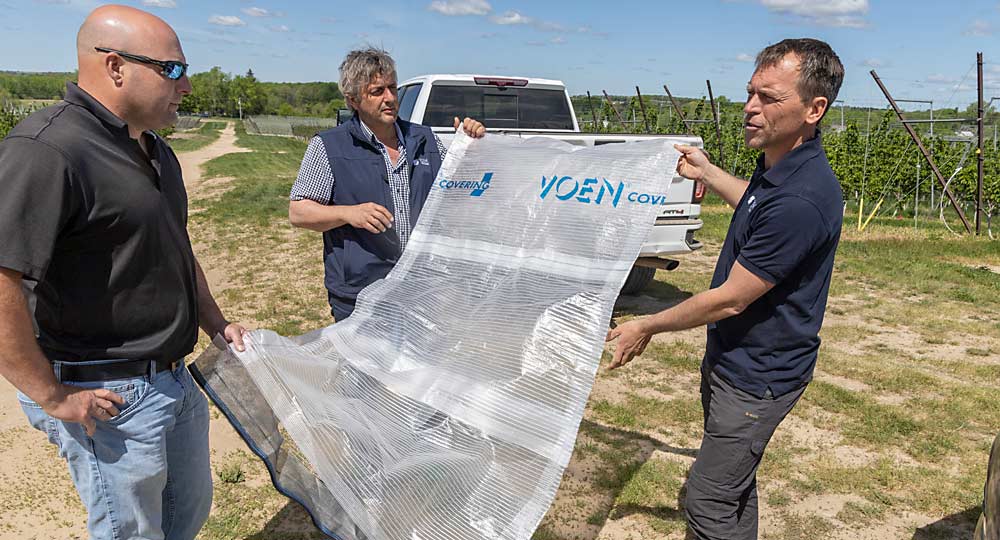
Riveridge Produce Marketing just established something new in Michigan: a covering system for commercial-scale sweet cherries.
The company’s main aim is to protect cherries from rain cracking, but it’s also looking to improve frost mitigation and hopes to boost pollination. Riveridge will cover 18 acres of sweet cherries this year, in two orchards that are a few years old and just coming into production, said operations manager Justin Finkler.
Riveridge Produce Marketing is known mainly as a grower, packer and marketer of apples based in Michigan’s Fruit Ridge north of Grand Rapids, but the company is moving more into sweet cherries to expand sales. There aren’t many large, fresh-market sweet cherry growers in the Midwest and on the East Coast, which creates an opportunity for local sales of the profitable crop. Growers venturing into sweet cherries need a consistent crop from year to year, however, which makes covering the fruit a necessity, Finkler said.
Michigan’s fresh-market sweet cherry industry remains small, made up mostly of farm market and U-pick operations. Lack of infrastructure and inconsistent crops impede growth, said Michigan State University horticulture professor Greg Lang.
Lang has been studying covering systems for sweet cherries for more than 15 years. He’s convinced they work, but growers still aren’t sure they’re worth the expense. That’s why he’s “thrilled” that Riveridge is trying a system. Growers will now see firsthand, from another grower, what covers can do. In rainy locations around the world, covering cherries is just part of the cost of doing business. They only need to save one or two crops to be worth the investment, he said.
“The Michigan industry will only grow and thrive once growers start putting protective covering systems in,” Lang said.
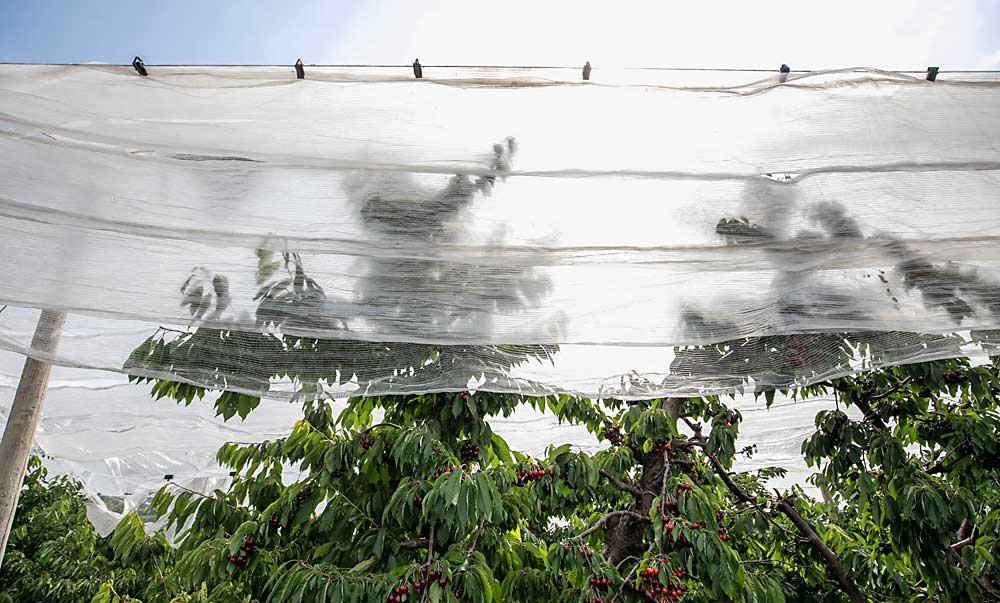
Consultation and installation
In May, VOEN Covering Systems owner Reinhard Vohringer and marketing and sales representative Jakob Fausboell visited the Riveridge cherry blocks for a consultation. The German company’s hands-on approach with customers is one of the reasons Riveridge went with VOEN, Finkler said.
The infrastructure for the covers was installed by the end of May, and Finkler said the nets would start going up in early June.
Riveridge has about 32 acres of sweet cherries right now and plans to plant an additional 100 acres in the next couple of years. They’ll add more covers as those plantings come into production, Finkler said.
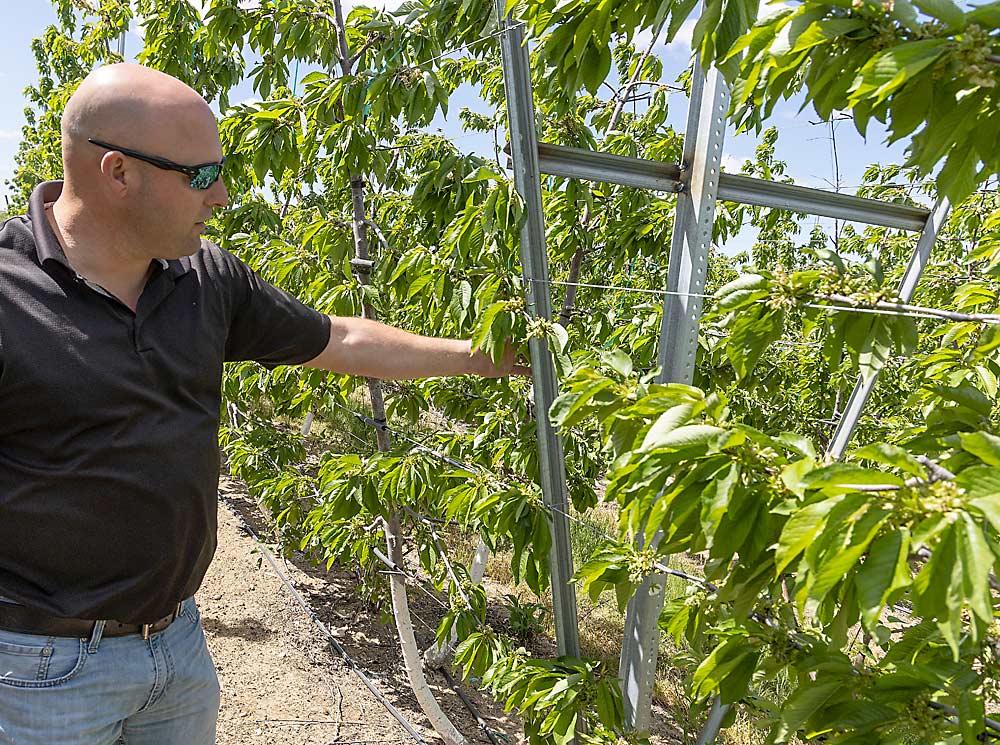
Skeena cherries on Gisela 5 rootstock, trained to a V trellis, comprise the biggest block being covered. Because Skeena is susceptible to rain cracking, Finkler said they designed the block with covers in mind when they planted it in 2018. They plan to add bird and insect netting next year.
Fausboell, who grows cherries in Denmark, said this marks VOEN’s first installation in Michigan. Infrastructure, cover and installation costs range from $25,000 to $28,000 per acre, depending on orchard layout and features selected. The covers normally pay for themselves within three years, he said.
Vohringer, a German stone fruit grower, invented the covering system 20 years ago. His region of southern Germany receives a lot of rain and heavy winds, and growing cherries without protection there is not sustainable, he said.
VOEN coverings also provide protection from frost, hail, wind and sunlight, and covered cherry trees require less water for irrigation. The coverings are hibernated at the top cable during winter and don’t need to be taken down until it’s time to replace them. The covers generally last eight to 10 years, Vohringer said.
Growers can operate vehicles, spray and perform other routine orchard work under the covers. VOEN doesn’t recommend sulfur sprays, however, because they can destroy the covers’ ultraviolet light protection. They offer another, more expensive, type of plastic cover to use with sulfur sprays, Vohringer said.
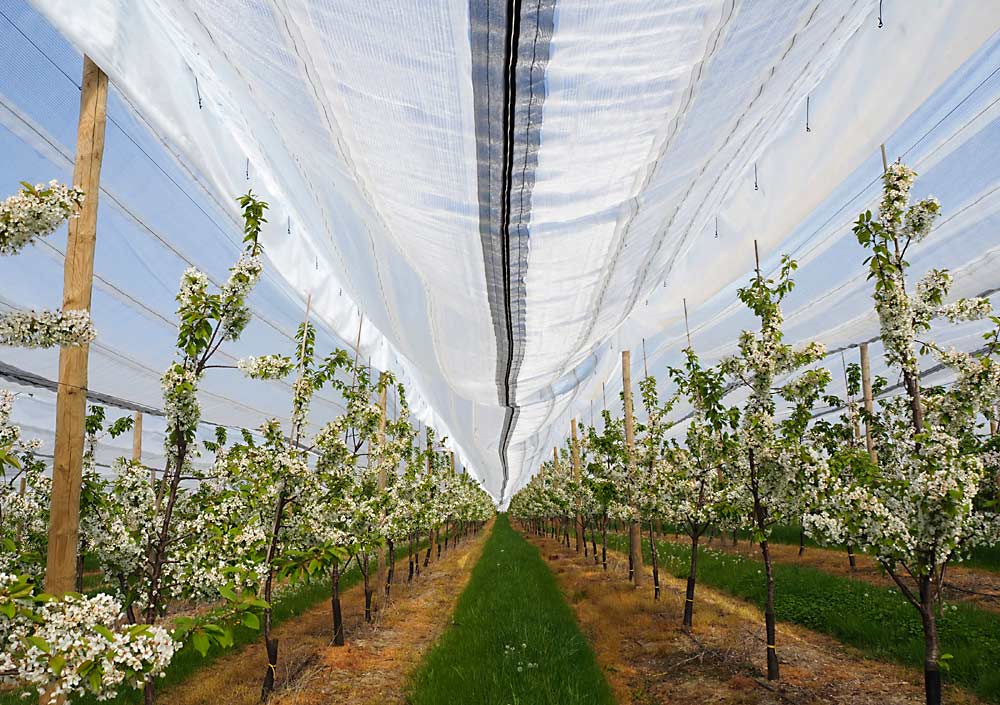
Lang said the biggest challenge with high tunnels and similar coverings is that they tend to trap heat. VOEN coverings are engineered to reduce that, but they don’t fully avoid it, he said.
Fausboell described the patented ventilation system: Plastic flaps are stitched to the covers. During rains, the weight of the water keeps the flaps closed. During dry periods, wind lifts the flaps and provides ventilation, removing accumulated heat and humidity. The system can be adapted to multiple training systems and spacings.
Users can install additional insect and bird protection layers. VOEN also offers heaters for frost protection, which can be placed under the covers. The heaters run on wood pellets, so their smoke doesn’t blacken the covers, Fausboell said.
Cornell University tree fruit physiologist Terence Robinson has studied VOEN systems in New York. He said the covers performed “spectacularly,” providing uncracked fruit every year.
“VOEN is the best system I have seen for rain crack prevention,” Robinson said. •
—by Matt Milkovich

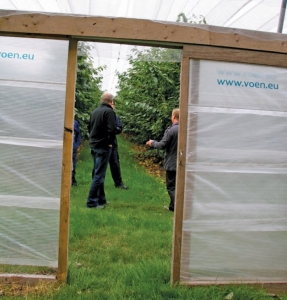





Leave A Comment